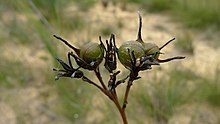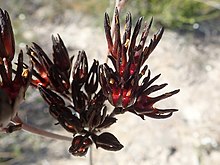| Haemodorum corymbosum | |
|---|---|

| |

| |
|
Scientific classification
| |
| Kingdom: | Plantae |
| Clade: | Tracheophytes |
| Clade: | Angiosperms |
| Clade: | Monocots |
| Clade: | Commelinids |
| Order: | Commelinales |
| Family: | Haemodoraceae |
| Genus: | Haemodorum |
| Species: | H. corymbosum
|
| Binomial name | |
| Haemodorum corymbosum | |

| |
| Collection records of H. corymbosum from AVH | |
Haemodorum corymbosum, commonly known as the rush-leaf bloodroot, is a shrub native to southeastern Australia. [1] Danish-Norwegian naturalist Martin Vahl described this species in his 1805 work Enumeratio Plantarum. [2]
It grows as a strappy herbaceous shrub 40–70 cm high, with three to four 40–75 cm long leaves arising from the base. These are narrow to terete and 1–1.5 mm in diameter. [1] Its roots contain a bright red pigment. Flowering occurs over the warmer months (October to January) and is profuse only after bushfire. [3] The brown-black flowers are 12–15 mm long and arranged in a corymb. [1]
Found in coastal areas from the Budawang Ranges to the vicinity of Gosford, [1] with one inland population at Agnes Banks, [3] Haemodorum corymbosum grows on sandy soils—occurring in swamps as well as sandstone ridges. It occurs with such woodland plants as Sydney red gum ( Angophora costata), sydney peppermint ( Eucalyptus piperita), scribbly gum ( E. sclerophylla), saw banksia ( Banksia serrata, and heathland plants such as dwarf apple ( Angophora hispida), scrub she-oak ( Allocasuarina distyla). [3]
References
- ^ a b c d Harden, Gwen J.. "Haemodorum corymbosum Vahl". PlantNET – New South Wales Flora Online. Royal Botanic Gardens & Domain Trust, Sydney Australia. Retrieved 28 August 2015.
- ^ Vahl, Martin (1805). Enumeratio Plantarum. Vol. 2. Havniae (Copenhagen): J.H. Schubothe. p. 179.
- ^ a b c Benson, Doug; McDougall, Lyn (2002). "Ecology of Sydney Plant Species Part 9: Monocotyledon families Agavaceae to Juncaginaceae" (PDF). Cunninghamia. 7 (4): 695–939 (see p. 822). Archived from the original (PDF) on 2009-06-14.
| Haemodorum corymbosum | |
|---|---|

| |

| |
|
Scientific classification
| |
| Kingdom: | Plantae |
| Clade: | Tracheophytes |
| Clade: | Angiosperms |
| Clade: | Monocots |
| Clade: | Commelinids |
| Order: | Commelinales |
| Family: | Haemodoraceae |
| Genus: | Haemodorum |
| Species: | H. corymbosum
|
| Binomial name | |
| Haemodorum corymbosum | |

| |
| Collection records of H. corymbosum from AVH | |
Haemodorum corymbosum, commonly known as the rush-leaf bloodroot, is a shrub native to southeastern Australia. [1] Danish-Norwegian naturalist Martin Vahl described this species in his 1805 work Enumeratio Plantarum. [2]
It grows as a strappy herbaceous shrub 40–70 cm high, with three to four 40–75 cm long leaves arising from the base. These are narrow to terete and 1–1.5 mm in diameter. [1] Its roots contain a bright red pigment. Flowering occurs over the warmer months (October to January) and is profuse only after bushfire. [3] The brown-black flowers are 12–15 mm long and arranged in a corymb. [1]
Found in coastal areas from the Budawang Ranges to the vicinity of Gosford, [1] with one inland population at Agnes Banks, [3] Haemodorum corymbosum grows on sandy soils—occurring in swamps as well as sandstone ridges. It occurs with such woodland plants as Sydney red gum ( Angophora costata), sydney peppermint ( Eucalyptus piperita), scribbly gum ( E. sclerophylla), saw banksia ( Banksia serrata, and heathland plants such as dwarf apple ( Angophora hispida), scrub she-oak ( Allocasuarina distyla). [3]
References
- ^ a b c d Harden, Gwen J.. "Haemodorum corymbosum Vahl". PlantNET – New South Wales Flora Online. Royal Botanic Gardens & Domain Trust, Sydney Australia. Retrieved 28 August 2015.
- ^ Vahl, Martin (1805). Enumeratio Plantarum. Vol. 2. Havniae (Copenhagen): J.H. Schubothe. p. 179.
- ^ a b c Benson, Doug; McDougall, Lyn (2002). "Ecology of Sydney Plant Species Part 9: Monocotyledon families Agavaceae to Juncaginaceae" (PDF). Cunninghamia. 7 (4): 695–939 (see p. 822). Archived from the original (PDF) on 2009-06-14.